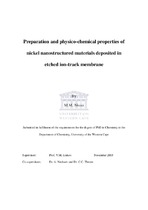| dc.description.abstract | The development of finely dispersed powders and superfine-grained materials intended for application in various areas of science and engineering is one of the challenges facing modern nanotechnology. Thus, specific fundamental and applied research was required in order to consolidate advancement made in preparing nano- and submicron crystalline composite materials. Useful templates for electrochemical deposition of nanowires include porous alumina films formed by anodic oxidation of aluminium, nuclear track-etched porous membranes, nanochannel array-glass and mesoporous channel hosts. The properties of the nanowires are directly related to the properties of the nanoporous templates such as, the relative pore orientations in the assembly, the pore size distribution, and the surface roughness of the pores. The template synthesis method, based on the use of porous polymeric and inorganic matrixes, is now actively used for synthesis of such composite materials. The method allows the chemical and/or electrochemical synthesis of nano- and microstructured tubes and wires consisting of conducting polymers, metals and semiconductors.In this study various technological challenges relating to template synthesis and development of nickel nano- and microstructures on adequately strong and durable substrates were investigated. The two methods used were the electrochemical and chemical deposition. “Hard nickel” bath solution was used for optimal nickel deposition. This optimization included investigating variables such as the template structure, type of electrolyte and form of electrolytic deposition. Scanning Electron Microscopy was used to investigate the structures of template matrixes and the resultant materials. The cyclic voltammetry method was applied for the analysis of electrochemical properties and hydrogen evaluation reaction of nano- and microstructured nickel based electrodes. The activity of composite nano- and microstructured materials in various configurations resulting from pore filling of template matrices by nickel was explored. Studies of the physical structure and chemical properties of the nanostructured materials included investigating the necessary parameters of template matrices. The optimum conditions of synthesis, which allowed development of materials with the highest catalytic activity, were determined. The effect of the template structure on microcrystallinity of the catalyst particles was established using the XRD method. Different new types of non-commercial asymmetric ion track membranes has been tested for nanostructure preparation. The catalytic activity of the new developed nanomaterials is higher as compared to materials using commercial templates. The procedures to modify the newly developed nickel catalyst with Pt, Pd and Pt-Pd alloy have been developed. The Pt and Pt-Pd alloy containing catalyst showed the best performance in water electrolysis. In this work, the promising role for specific application of the new materials in hydrogen economy has been demonstrated. | en_US |

